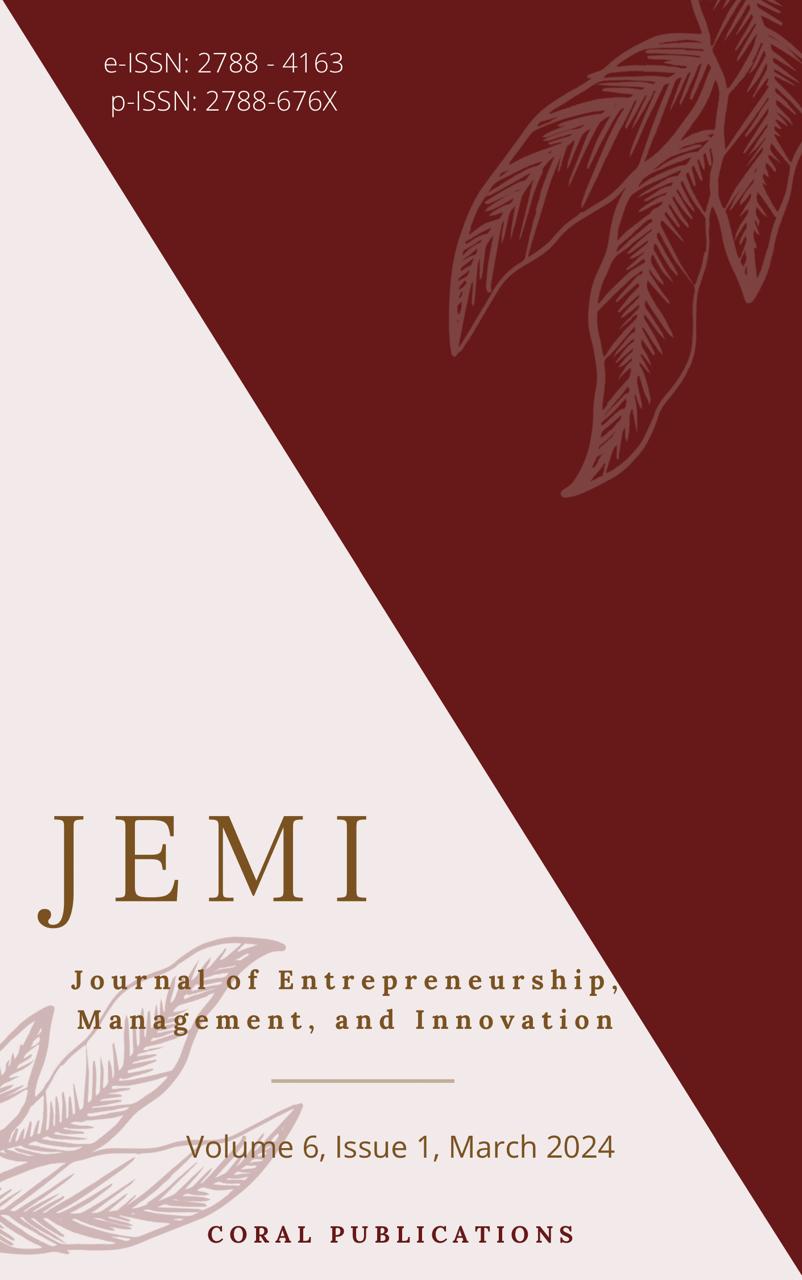Investigating Financial Resource Sufficiency for Entrepreneurial Growth: A Case of SMEs in Pakistan
DOI:
https://doi.org/10.52633/jemi.v6i2.381Keywords:
Financial Resources, SMEs, Entrepreneurship, Entrepreneurial Ventures, Challenges, StrategiesAbstract
This research paper delves into the critical nexus between entrepreneurship and finance, focusing on entrepreneurs' challenges and strategies in accessing and utilizing financial resources to increase growth. The study highlights the fundamental role of finance in enabling small entrepreneurial ventures to thrive and contribute to economic development. It then proceeds to identify key challenges, including access to capital, financial literacy gaps, and regulatory barriers that hinder entrepreneurial finance. Through a comprehensive review of existing literature and case studies, the paper explores the various strategies entrepreneurs employ to overcome these challenges, including traditional financing methods, alternative funding sources such as crowdfunding, venture capital, and financial management techniques. Additionally, the research discusses the evolving landscape of fintech solutions and their impact on facilitating access to finance for entrepreneurs. Moreover, it examines the role of government policies and institutional support in fostering an enabling environment for entrepreneurial finance. The results of this study present valuable recommendations for policymakers, financial institutions, and entrepreneurs seeking to understand the complex landscape of entrepreneurial finance and focus on strategies to exploit the full potential of innovative ventures.
References
Allen, F., Carletti, E., & Marquez, R. (2011). Credit market competition and capital regulation. The Review of Financial Studies, 24(4), 983-1018. https://doi.org/10.1093/rfs/hhp089
Ansoff, H. I. (1957). Strategies for diversification. Harvard Business Review, 35(5), 113-124.
Armendáriz, B., & Morduch, J. (2010). The economics of microfinance. MIT Press.
Barney, J. (1991). Firm resources and sustained competitive advantage. Journal of Management, 17(1), 99-120. https://doi.org/10.1177/014920639101700108
Bashir, M. (2023). The influence of strategic flexibility on SME performance: is business model innovation the missing link?. International Journal of Innovation Science, 15(5), 799-816.
Beck, T., Demirgüç-Kunt, A., & Levine, R. (2006). Bank concentration, competition, and crises: First results. Journal of banking & finance, 30(5), 1581-1603.
Beck, T., Demirgüç-Kunt, A., & Maksimovic, V. (2008). Financing patterns around the world: Are small firms different?. Journal of financial economics, 89(3), 467-487.
Belleflamme, P., Lambert, T., & Schwienbacher, A. (2014). Crowdfunding: Tapping the right crowd. Journal of Business Venturing, 29(5), 585-609.
Berger, A. N., Saunders, A., Scalise, J. M., & Udell, G. F. (1998). The effects of bank mergers and acquisitions on small business lending. Journal of Financial Economics, 50(2), 187-229.
Bhide, A. (1992). Bootstrap finance: The art of start-ups. Harvard Business Review, 70(6), 109-117.
Brealey, R. A., Myers, S. C., & Allen, F. (2014). Principles of Corporate Finance. McGraw-Hill.
Brinckmann, J., Salomo, S., & Gemuenden, H. G. (2011). Financial management competence of founding teams and growth of new technology-based firms. Entrepreneurship Theory and Practice, 35(2), 217-243. https://10.1111/j.1540-6520.2009.00362.x
Cavaliere, L. P. L., Keswani, S., Kumar, S., Mathew, S., Das, S., Hasan, M. F., ... & Regin, R. (2021). The impact of portfolio diversification on risk management practices. Nveo-Natural Volatiles & Essential Oils Journal| NVEO, 8447-8469.
Cull, R., Demirgüç-Kunt, A., & Morduch, J. (2009). Microfinance meets the market. Journal of Economic Perspectives, 23(1), 167-192.
Djankov, S., La Porta, R., Lopez-de-Silanes, F., & Shleifer, A. (2002). The regulation of entry. The Quarterly Journal of Economics, 117(1), 1-37.
Ebben, J., & Johnson, A. (2006). Bootstrapping in small firms: An empirical analysis of change over time. Journal of Business Venturing, 21(6), 851-865.
Esteller-More, A., Rizzo, L., & Secomandi, R. (2020). The heterogeneous impact of taxation on FDI: A note on Djankov et al. (2010). Economics Letters, 186, 108775.
Fazzari, S., Hubbard, R. G., & Petersen, B. (1988). Investment, financing decisions, and tax policy. The American Economic Review, 78(2), 200-205.
Gompers, P., & Lerner, J. (2001). The venture capital revolution. Journal of economic perspectives, 15(2), 145-168.
Klapper, L., Lusardi, A., & Panos, G. A. (2013). Financial literacy and its consequences: Evidence from Russia during the financial crisis. Journal of Banking & Finance, 37(10), 3904-3923.
Markowitz, H. (1952). The utility of wealth. Journal of Political Economy, 60(2), 151-158.
Mokdadi, S., & Saadaoui, Z. (2023). Geopolitical uncertainty and the cost of debt financing: the moderating role of information asymmetry. The Journal of Risk Finance, 24(5), 684-720. https://doi.org/10.1108/JRF-12-2022-0308
Naili, M., & Lahrichi, Y. (2022). The determinants of banks' credit risk: Review of the literature and future research agenda. International Journal of Finance & Economics, 27(1), 334-360.
Perry, S. C. (2001). The relationship between written business plans and the failure of small businesses in the US. Journal of Small Business Management, 39(3), 201-208.
Peteraf, M. A., & Bergen, M. E. (2003). Scanning dynamic competitive landscapes: a market‐based and resource‐based framework. Strategic Management Journal, 24(10), 1027-1041.
Piperopoulos, P. G. (2016). Entrepreneurship, innovation, and business clusters. Routledge.
Ramzan, M. (2021). Symmetric impact of exchange rate volatility on foreign direct investment in Pakistan: do the global financial crises and political regimes matter?. Annals of Financial Economics, 16(04), 2250007.
Shahbaz, M., Ahmad, K., & Chaudhary, A. R. (2008). Economic growth and its determinants in Pakistan. Pakistan Development Review, 471-486.
Sohilauw, M. I., Nohong, M., & Sylvana, A. (2020). The relationship between financial literacy, rational financing decision, and financial performance: An empirical study of small and medium enterprises in Makassar. Jurnal Pengurusan, 59, 89-102.
Stiglitz, J. E., & Weiss, A. (1981). Credit rationing in markets with imperfect information. The American Economic Review, 71(3), 393-410.
Wang, K., Hu, Y., Zhou, J., & Hu, F. (2023). Fintech, financial constraints, and OFDI: Evidence from China. Global Economic Review, 52(4), 326-345. https://10.1080/1226508X.2023.2283878
Zider, B. (1998). How venture capital works. Harvard Business Review, 76(6), 131-139.
Downloads
Published
Issue
Section
License
Copyright (c) 2024 Maria Shaikh, Imamuddin Khoso, Muhammad Ovais Jummani (Author)

This work is licensed under a Creative Commons Attribution 4.0 International License.











